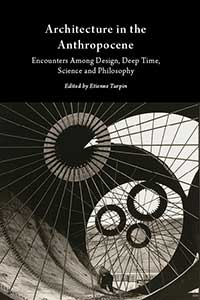Architecture in the Anthropocene: Encounters Among Design, Deep Time, Science and Philosophy
edited by Etienne Turpin

- Critical Climate Change
- Published: 2014
- ISBN: 978-1-60785-307-7
Research regarding the significance and consequence of anthropogenic transformations of the earth’s land, oceans, biosphere and climate have demonstrated that, from a wide variety of perspectives, it is very likely that humans have initiated a new geological epoch, their own. First labeled the Anthropocene by the chemist Paul Crutzen, the consideration of the merits of the Anthropocene thesis by the International Commission on Stratigraphy and the International Union of Geological Sciences has also garnered the attention of philosophers, historians, and legal scholars, as well as an increasing number of researchers from a range of scientific backgrounds. Architecture in the Anthropocene: Encounters Among Design, Deep Time, Science and Philosophy intensifies the potential of this multidisciplinary discourse by bringing together essays, conversations, and design proposals that respond to the “geological imperative” for contemporary architecture scholarship and practice. Contributors include Nabil Ahmed, Meghan Archer, Adam Bobbette, Emily Cheng, Heather Davis, Sara Dean, Seth Denizen, Mark Dorrian, Elizabeth Grosz, Lisa Hirmer, Jane Hutton, Eleanor Kaufman, Amy Catania Kulper, Clinton Langevin, Michael C.C. Lin, Amy Norris, John Palmesino, Chester Rennie, François Roche, Ann-Sofi Rönnskog, Isabelle Stengers, Paulo Tavares, Etienne Turpin, Eyal Weizman, Jane Wolff, Guy Zimmerman.
“Although architecture has a sense of its place within broader socio-political and cultural systems, it has not, until very recently, acknowledged itself as part of the earth’s geology, despite the fact that it is a forceful geological agent, digging up, mobilizing, transforming and transporting earth materials, water, air and energy in unparalleled ways. With the Anthropocene thesis, architecture is called to think itself as a geological actor capable of radically transforming the earth’s atmosphere, surface morphology, and future stratigraphy. This extraordinary and provocative collection of essays, design projects, and conversations plots out what the geological discourse of the Anthropocene might mean for architecture, architectural theory, and design practice.”Lindsay Bremner – Director of Architectural Research, University of Westminster“The ground on which we stand—physically, conceptually, even ontologically—is becoming increasingly unstable. The same goes for our political, scientific, and planetary atmospheres. The histories of “civilisation” and “nature” are crossing paths. But how to live up to the transformation called the Anthropocene? Vectors of critical thought that align planetary politics with questions of the planning, organization, the design of physical space and the making of environments have become urgent. This volume brings leading and emerging scholars and design practitioners together, allowing the most exciting edges of new research to speak to each other. It is a major contribution to an emerging field of study and will shape the direction of the expanded field in architectural and spatial research.”Anselm Franke – Head of Visual Arts and Film Department, Haus der Kulturen der WeltEditor Bio
Etienne Turpin is a philosopher studying, curating, designing and writing about complex urban systems, political economies of data and infrastructure, visual culture and aesthetic practices, and Southeast Asian colonial–scientific history. In Jakarta, Etienne is the director of anexact office and the co–principal investigator, with Tomas Holderness, of PetaJakarta.org. At the University of Wollongong, Etienne is the Vice–Chancellor’s Postdoctoral Research Fellow with the SMART Infrastructure Facility and an Associate Research Fellow with the Australian Center for Cultural Environmental Research. He is also a member of the SYNAPSE International Curators’ Network of the Haus der Kulturen der Welt in Berlin, where he is the co–editor, with Anna–Sophie Springer, of the intercalations: paginated exhibition series as part of the Das AnthropozänProjekt. He is the editor of Architecture in the Anthropocene: Encounters Among Design, Deep Time, Science and Philosophy (Open Humanities Press, 2013) and co–editor of Jakarta: Architecture + Adaptation (Universitas Indonesia Press, 2013).
